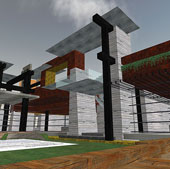Last week I had a pretty interesting email conversation with Ryan Schultz about Second Life (not to be confused with First Life) and its potential for architectural collaboration. In a nutshell I am not a fan of Second Life. Certainlly one day 3D will play a much stronger role in our experience of the Web but I don't believe Second Life is 'it'. If you are interested in reading our conversation then Ryan has done a pretty good job of presenting it on his Studio Wikitecture site. I come off sounding reasonably intelligent which I guess means those long hours of watching Discovery Channel are beginning to pay off.
I can’t help but feel the online 3D market is at the same place as the 2D online world was between 1990 and 1995. Back then we had walled gardens like Compuserve, AOL and even Microsoft Network (which originally shipped with Windows 95). Whilst these communities had a lot of money behind them the rapid adoption of open HTML and HTTP concepts quickly usurped them.
When it comes to 3D architectural collaboration I really do not see much of a role for entirely immersive worlds like Second Life in a business context. Immersive worlds like Second Life or World of Warcraft have a tonne of conceptual baggage that is part and parcel with the whole experience. Your average business person, be it client or architect, just wants to focus on the job and hand which is interogating and understanding the building design in a clear and comprehensive manner. 3D is just one avenue for this exploration, conventional 2D architecture drawings and conversation is no less important. Because of these demands architectural collaboration will continue to trend towards standalone and portable 2D/3D media such as DWF and PDF rather than moving into online worlds. These are relatively lightweight and immediately accessible mediums compared to Second Life, where just finding the architecture could prove problematic for unaccustomed users.
Another undiscussed factor which is just impossible to shake off is the stigma associated with any entertainment-centric technology when applied to a business problem. For ten years I have been watching demonstrations of how architecture can be 'experienced' within a 3D game engine yet nothing has really come out of it apart from a lot of promising demos and the odd chuckle when a reviewer gets bored and decides to virtually shoot the other attendees. Whilst it may seem a little silly I think deep down many people just cannot take these derived tools seriously (although they would never admit it). This may change over time, especially as the generations who have grown up with Doom and Quake begin to ascend corporate ladders. However until such a time I think any architectural visualisation experience centered around entertainment or gaming technology is going to struggle for credibility in what is in general a fairly conservative AEC market.

